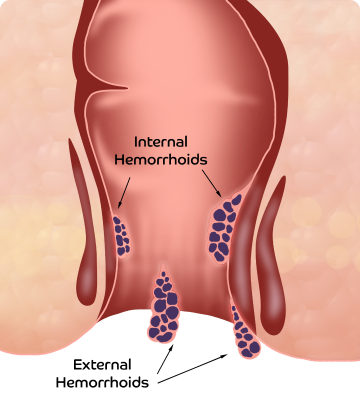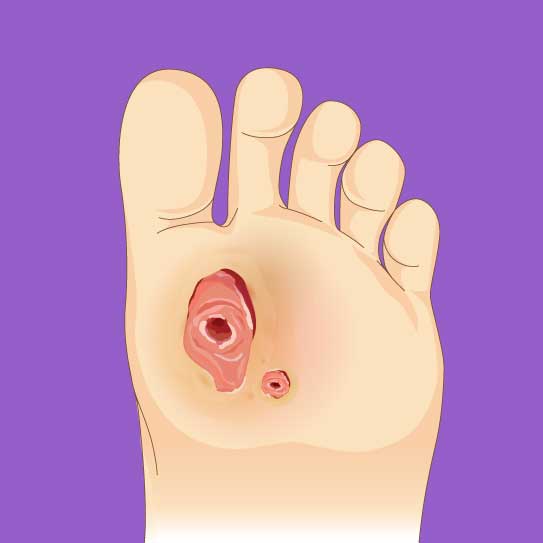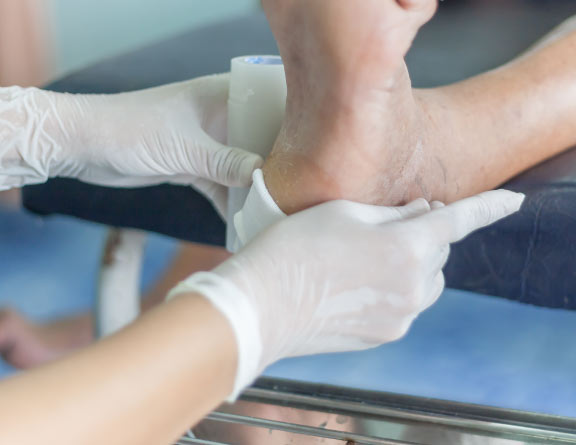What are the different types of diabetic foot ulcers?
There are primarily three types of diabetic foot ulcers-
- Neuropathic Ulcers- In patients that have peripheral diabetic neuropathy which can severely damage their peripheral nerves and lead to ulcer formation. It causes loss of sensation in the nerves, especially in the legs which further makes it harder to notice the ulcer in the foot.
Ischemic Ulcers- These ulcers start to form in the legs where the blood flow is poor. When the cells don’t get enough blood, they start to die and damage the tissues leading to ischemic ulcers on the feet and legs. - Neuroischemic Ulcers- It is a type of ulcer that forms when neuropathy and ischemic ulcers co-exist. It forms on the margins of the foot and over time becomes so serious that eventually amputation is needed if they are not treated in time.
Out of all the cases of diabetic foot ulcers, more than 50% of cases are neuroischemic ulcers, 36% are neuropathic, and 11% are purely ischemic. Regardless of the type of ulcer you have, it is important that you get it treated as soon as possible. For optimal care and advanced treatment, you can get in touch with Pristyn Care and consult the best doctors in .
What are the different grades of diabetic foot ulcers?
Diabetic foot ulcers are divided into different grades depending on its effect on the leg.
- Grade 0- Intact Skin- The foot ulcers are not present and there are no signs of any kind of scrape or injury on the leg as well.
- Grade 1- Superficial ulcer of skin- In this grade, an ulcer starts to appear over the subcutaneous tissues only.
- Grade 2- Ulcers extension into tendon, bone, and capsule- The ulcer becomes deep and starts penetrating the surface of the muscles, ligaments, joint capsule, and deep fascia.
- Grade 3- Deep ulcer with osteomyelitis or abscess- At this grade, the ulcer reaches down to the connective tissue layer and an abscess may also start to form that may reach to the tendon, muscle, joint, or bone.
- Grade 4- Partial foot gangrene- At this grade, the tissues around the ulcer start to die slowly in a localized portion of the foot.
- Grade 5- Whole foot gangrene- It is the most severe stage where a significant amount of tissues die and extensive gangrene is present around the ulcer.
In patients whose conditions reach Grade 5, the diabetic foot ulcer becomes so severe that amputation is required to prevent the infection from spreading to the other body parts. Therefore, it is important that you see a specialist as soon as possible to prevent the ulcer from advancing.
Consult with Pristyn Care’s Expert Vascular Doctors in for of Diabetic Foot Ulcer Treatment
Pristyn Care houses a team of best vascular surgeons in who are well-experienced and have ample experience in treating all kinds of vascular problems. The doctor will diagnose the condition and determine the most appropriate treatment method for the patient. Our doctors have helped hundreds of patients to resolve the problem effectively with the help of non-surgical techniques, such as hyperbaric oxygen therapy, total off casting, etc. They also specialize in surgical treatments, such as debridement, reconstructive foot and ankle surgery, and vascular reconstruction. You can rely on our doctors to suggest the most suitable treatment method that will successfully treat the diabetic foot ulcer.
How can I prevent diabetic foot ulcers from forming?
- Take care of your health if you have diabetes and follow the doctor’s advice strictly to keep your blood sugar in check.
- Wash your legs with warm water and always check the temperature as extremely hot water may burn the skin.
- Check the leg and feet for sores, blisters, calluses, or any other kind of injuries.
- Make sure that your feet don’t become too dry. Use moisturizer to avoid dry skin problems.
- If there are calluses forming the feet, use a pumice stone or emery board to remove them right after a bath.
- Wear stockings or socks that fit you well instead of walking barefoot.
- Protect your feet from extreme cold and heat.
- Ensure that the blood flow in the legs is maintained properly.
- Keep your feet up while sitting for prolonged hours, move your ankles, wiggle the toes, and don’t sit cross-legged for long duration.
- If you smoke or drink alcohol on a regular basis, stop right away as these habits will make the foot ulcer worse.
- Visit a doctor regularly to keep diabetes in control and to get your feet checked.
If an ulcer has started to form, contact a vascular specialist right away for timely treatment. By seeking treatment on time, the surgeon may be able to resolve the problem without performing any surgical procedure. If the ulcer reaches the bone and tissues start to die, then surgery will be needed for effective treatment.
Book An Appointment with Pristyn Care Today
You can book a consultation with Pristyn Care doctors by using our dedicated mobile application. The app can be downloaded on iOS and Android devices as well. You can download the app to browse the list of doctors available in . Pick a doctor of your choice and confirm the appointment directly.
You can also give us a call or fill the “Book Appointment” form and submit your details. Our medical coordinators will talk to you and discuss the appointment details.











.svg)









